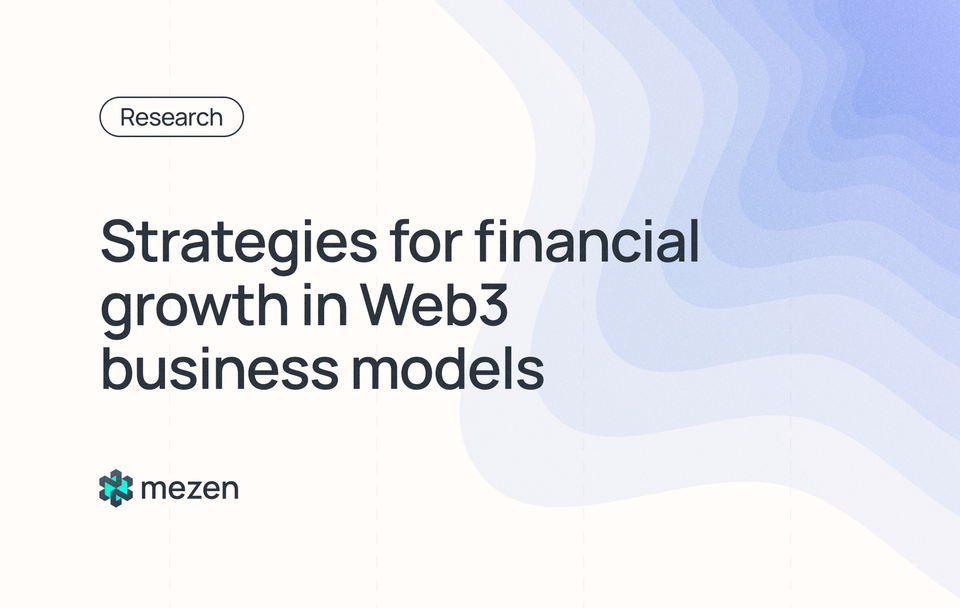Strategies for financial growth in Web3 business models

Even in the high-tech world of Web3 business, it is crucial to continuously improve business models to enhance efficiency and competitiveness. In a rapidly changing digital landscape, successful companies must adapt and leverage advanced technologies to achieve sustainable growth. In this article, we will explore ways to boost financial growth and stability using both classic and new Web3 tools.
Issuing a native asset
One of the foundational strategies for financial growth in Web3 is the issuance of native assets or cryptocurrencies. These assets can be used within the network to incentivize participants, ensure security, and promote growth.
This strategy motivates miners to maintain network security by increasing the cost of attacks, making the system more robust. The increase in the value and security of the native asset raises its demand and price, which contributes to the financial growth and stability of the Web3 business model.
Bitcoin Network implements this strategy through the use of Proof of Work, where BTC is awarded to miners for successfully mining blocks. This creates an economic incentive to maintain the network’s security and stability, increasing the value and demand for BTC.
Holding the native asset & building the network
Holding the native asset and building the network involves accumulating large reserves of cryptocurrency and developing a functional ecosystem to enhance its value.
Companies like Blockstream and ConsenSys demonstrate how leveraging their cryptocurrency holdings can boost the value of the network. This strategy requires significant initial investments and a long-term commitment to ecosystem development. As a result, the asset's value increases, providing stable income and strengthening financial sustainability and market position. Successful ecosystem development around the native asset also attracts new users and partners, enhancing the network and its influence.
Taxation on speculation (exchanges)
Taxation on speculation involves creating financial infrastructure for crypto assets, such as exchanges and custodial services, to serve traders.
Exchanges like Coinbase and Bitstamp not only make crypto assets more accessible but also contribute to their popularization. They provide liquidity and reliability, which strengthens the financial system and attracts more users. Increased trading volumes boost company revenues, supporting financial growth and stability. Having a developed infrastructure lowers market entry barriers and stimulates further development of the Web3 ecosystem.
Payment tokens
The use of payment tokens involves creating two-sided marketplaces where transactions require the use of the network’s native token.
As the network economy grows, the demand for the limited native payment token increases, leading to a rise in its value. This model allows companies to effectively monetize their platforms and incentivize the use of tokens. However, the complexity of using tokens can detract from the user experience, so successful implementation requires a careful balance between convenience and functionality. In the long term, increasing token value supports the financial growth and stability of the company.
ConsenSys develops the Ethereum (ETH) ecosystem by requiring users to use ETH for transaction fees and services on the platform, stimulating demand for ETH and supporting its value, thereby contributing to the company's financial sustainability.
Burning tokens
Burning tokens involves using revenues to buy back and destroy native tokens, reducing their total supply.
Successful examples of this model include Binance (BNB) and MakerDAO (MKR) tokens. Burning tokens creates a sustainable model that supports the token’s value growth, increasing user and investor confidence. This strategy contributes to the financial stability of the company and ensures competitive advantages in the market. By regularly buying back and burning BNB, Binance reduces the total number of tokens in circulation, increasing their value and maintaining user trust.
Work tokens
Work tokens focus on ensuring the provision of services in decentralized networks by requiring service providers to hold a certain amount of tokens to operate within the network.
Work tokens like REP from Augur and KEEP from Keep Network create a powerful incentive system for service providers, rewarding them for honest work. This supports the sustainable development of the network and provides stable income for participants. Future expected cash flows from network services determine the value of these tokens, making them attractive to investors. Consequently, this model promotes the financial growth and long-term sustainability of the company.
Blockchain-as-a-Service (BaaS)
Blockchain-as-a-Service (BaaS) provides platforms for creating and deploying blockchain applications without the need to manage infrastructure.
Using BaaS allows companies to reduce costs associated with creating and maintaining blockchain infrastructure, enabling them to focus on their core business processes. This accelerates innovation and increases business efficiency, ultimately leading to financial growth and stability.
Hyperledger Cello, supported by the Linux Foundation, offers a standardized set of tools for developing blockchain applications, making it easier for companies to experiment with and adopt blockchain technologies without significant initial infrastructure costs.
Low-code & No-code Web3
Low-code and No-code Web3 platforms allow the creation of decentralized applications without the need to write code, using pre-built components.
These platforms lower the barriers to entry for developing Web3 applications, making them accessible to a broad range of users, including those without technical skills. This accelerates the development and deployment process, enabling companies to bring products to market more quickly and adapt to changing conditions. Truffle Suite is a popular Low-code platform for developing Web3 applications on Ethereum, providing tools for creating, testing, and deploying decentralized applications (dApps) efficiently. This approach fosters innovation and growth by enabling faster and more inclusive development of Web3 solutions.
Bottom line
The Web3 environment offers unique opportunities for expanding existing business models aimed at enhancing business efficiency and sustainability. Implementing strategies such as issuing and holding native assets, creating decentralized financial services, integrating NFTs, and using low-code platforms enables companies to effectively monetize their offerings, improve user experience, and generate new revenue streams.
Leveraging the advantages of Web3 will help companies reach new heights, ensuring growth and stability in the rapidly changing digital world. It is crucial to keep pace with the times, adopting advanced technologies, and not fearing change. Adapting to new conditions and utilizing innovative solutions will be key success factors in the Web3 era.


Comments ()